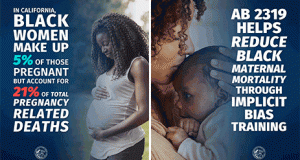Fifty years after the Kerner Commission criticized the news media for not sufficiently covering race issues, a new special report shows that women of color continue to be underrepresented in U.S. newsrooms and face multiple challenges in achieving equality in hiring and promotions.
The Women’s Media Center report “The Status of Women of Color in the U.S. News Media 2018” offers a rare look at where women journalists of color are — and aren’t — in legacy print, radio, TV, and digital news. It is an important extension and extrapolation of data previously published in the Women’s Media Center’s annual “The Status of Women in the U.S. Media” study, and includes data about minority journalists released after the most recent version of that report was produced in 2017.
Women of color represent just 7.95 percent of U.S. print newsrooms overall, 12.6 percent of local TV news staff, and 6.2 percent of local radio staff, according to industry research that is based on news organizations’ replies to professional association queries.
“Whether intentional or not, it seems like there is a cap on people of color in newsrooms,” said Rummana Hussain, assistant metro editor, Chicago Sun-Times.
Among the journalism professionals offering their trenchant views in the report on what’s broken for women journalists of color, and how to repair the breach are journalist and author Dana Canedy, the first black female and youngest person to helm the Pulitzer Prize organization; such marquee broadcast news leaders as Soledad O’Brien, Ann Curry, Maria Hinojosa and Joy Reid; MacArthur “genius grant” winner Nikole Hannah-Jones; freelance journalist Jenni Monet; and women of far less fame who likewise excel in practicing their craft.
“There are so many micro-aggressions that come with being a journalist and female and not White,” according to Soledad O’Brien, founder and CEO, Starfish Media Group. “If you spend too much time seeing yourself — in terms of how they see you — as only those things, you will lose your mind. Because there are just a lot of slights.”
The report comes at a time when the nation’s population is changing rapidly. The U.S. Census projects that Blacks, Asians, Hispanics, Native Americans, Pacific Islanders, and those who are multi-racial will be the majority of the population by 2050.
“Women are more than half the U.S. population, and people of color nearly 40 percent,” said Julie Burton, president of the Women’s Media Center. “But you wouldn’t know this from our media — because U.S. media does not look like, sound like, or reflect the diversity and experience of more than half the population.”
While acknowledging their successes, the women journalists of color say systemic racism, the old boys’ network, and gender bias, among other obstacles, are some of the reasons newsrooms are slow to change.
“Many, many talented women of color are rising through the ranks, as they have since the late ’60s and ’70s,” said Ann Curry, executive producer, reporter, host, We’ll Meet Again on PBS. “One of the most significant reasons they fail is that men tend to groom men.”
News staffs that reflect our nation’s racial, ethnic, and gender diversity are intrinsic to creating a credible media and to the nation’s democracy, said Gloria Steinem, WMC co-founder.
“Missing women of color in the newsrooms of this country is an injustice in itself, and an injustice to every American reader and viewer who is deprived of great stories and a full range of facts,” Steinem said. “Inclusiveness in the newsroom means inclusiveness in the news. Racism and sexism put blinders on everyone.”
“Women of color represent a substantial proportion of the population, and yet their stories are too rarely told and their voices too infrequently heard on most media platforms,” said Maya Harris, WMC co-chair. “The perspectives and findings this Women’s Media Center report offers not only illuminate this lost opportunity, but also help to identify what we must do to work toward a more inclusive democracy.”
Said Pat Mitchell, WMC board co-chair: “Fifty years after the Kerner Commission report, women of color are still battling systemic racism and sexism in the news media. It is imperative that Black, Asian, Hispanic, and Native women be more visible and powerful in media. The Women’s Media Center won’t rest until our newsrooms are inclusive, representative, and equal.”
The report, compiled and written by journalist and custom content producer Katti Gray and edited by Cristal Williams Chancellor, WMC’s director of communications, offers solutions to editors, producers, publishers, and other news executives, including the need to intentionally search for talented women of color, increased accountability and transparency by news organizations, and innovative recruitment and hiring strategies. Both Gray and Williams Chancellor are veteran, award-winning journalists.
“I don’t believe in embarrassing and shaming people, but I do believe in giving them actual solutions, people they can hire tomorrow,” said Benét Wilson, founder and editor-in-chief of Aviation Queen LLC and vice president of the Online News Association. “We don’t want to hear the excuses anymore.”
The industry studies on gender and race used in the report were released last year by the American Society of News Editors and the Radio Television Digital News Association.
The Women’s Media Center, co-founded by Jane Fonda, Robin Morgan, and Steinem, works to make women visible and powerful in the media. We do so by promoting women as decision makers and as subjects in media; training women to be media ready and media savvy; researching and exposing sexism and racism in media; and creating original online and on-air journalism.
For more information, contact Williams Chancellor at cristal@womensmediacenter.com or 202-270-8539.
The full report is available here.
The infographic is available here.
 Westside Story Newspaper – Online The News of The Empire – Sharing the Quest for Excellence
Westside Story Newspaper – Online The News of The Empire – Sharing the Quest for Excellence




